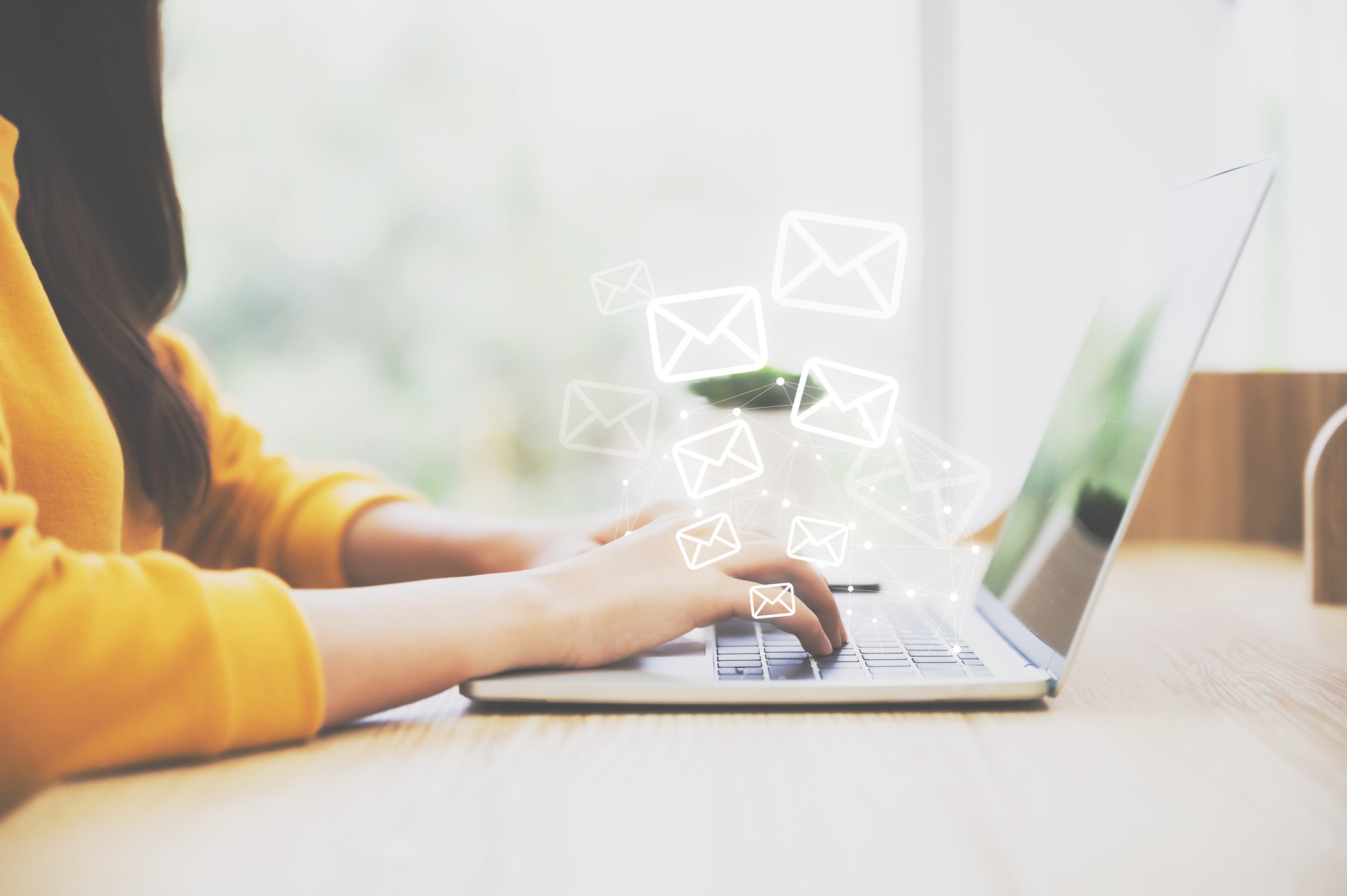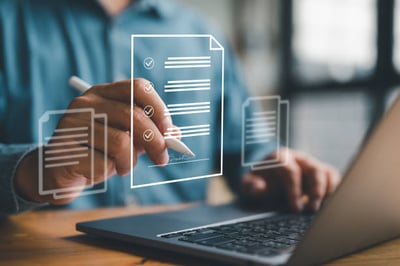September 5, 2024
 by Alex Souchoroukof / September 5, 2024
by Alex Souchoroukof / September 5, 2024

One of the most efficient channels for communication, both inside and outside of an organization, is email.
Regardless of your position, you will probably utilize email for its effectiveness. You might have to write a letter of introduction, exchange information, communicate a critical update, or summarize an important meeting.
A well-written email gives the recipient a welcoming, concise, and actionable message. Writing emails that adhere to these requirements can be learned with practice. You must compose your email professionally if you want it to stand out, clicked on, and read.
In this post, we'll go over creating a professional email that grabs the reader's attention and helps them take action, regardless of whether you manually send emails or use email marketing automation.
There are several approaches to writing a professional email. It could be a thank you letter, a letter of resignation to your employer, or a cover letter with a CV for a job application. Whatever your motive for sending an email, you must craft a professional note to increase the chances of success.
Like other forms of communication, you should introduce yourself before explaining the purpose of the email and asking the recipient to take action. A professional email does not look like the example below.
Source: Moosend
A professional email must be meticulously crafted with specific elements that we will analyze in the following section.
Every professional email can be divided into the same fundamental parts. You may not use all of these components, but you should always carefully consider each one.
It is impossible to undervalue the effectiveness of a well-structured, professional email that gets the point across in the fewest possible words and motivates the reader to act. To better understand how to create that experience, here is a list of the elements to keep in mind when writing.
The email subject line, along with your name or email address, will be what the receiver sees before deciding whether or not to click on your email. As a result, you want to ensure you're articulating your message's purpose and establishing expectations.
It must also be compelling to persuade the recipient to open the email. No matter how well-structured your email body is, if the subject line doesn't grab their attention, they might not even open it, and that's the last thing you want as a professional.
Here are some subject line tips to keep in mind for your next professional email:
For instance, if you need to postpone a meeting, you could write, "Hey [first name], can we please reschedule the meeting?" Similarly, if you want to invite someone to a webinar, you could write, "[first name], here is your chance to learn everything about email marketing!"
Source: Moosend
Pro tip: While crafting subject lines for cold emails, remember not to mislead the audience by writing clickbait subject lines. Always be genuine, using a concise subject line that conveys your message while respecting their time.
Making the greatest possible first impression with a formal salutation, commonly referred to as a greeting, is crucial when composing a professional email.
It's crucial because failing to spell someone's name correctly or using the incorrect greeting could hurt how they see you. Giving the welcome enough thought establishes the tone for the entire email.
Unless the recipient works for a more formal organization where their full name could be more suitable, using the first name only is sufficient in most professional discussions.
It's always preferable to use someone's first or last name rather than mistakenly using "Ms." or "Mr." However, the preferred format for professors and doctors is typically their title followed by their last name.
If you are unsure of the recipient's identity, you can sometimes start your email by writing "Hello" or "Hi there" instead of their name.
Pro tip: It is polite to start by thanking the recipient, whether you are communicating with someone for the first time, responding to their inquiry, or receiving feedback. The reader will be more open to what you have to say next if you express gratitude.
In the email body, you must include the information you want to communicate with your recipient. When writing professional emails, use appropriate language for the circumstance and avoid using spam words. State clearly why you are sending the message and what action you hope the receiver will take after reading.
Always start with an introduction about yourself. This is crucial, especially if it's the first time emailing someone. This can be a brief paragraph of one to two sentences about you that fits the message's goal.
Here are some tips:
After introducing yourself, you can start explaining the context of your email. The email body should thoroughly explain the message you wish to send, how the receiver can benefit from it, and what you are waiting for from them.
Nobody has the time to read a long, difficult-to-read email with no context, so keep it simple and concise. Pay attention to how much you can say with fewer words.
Here are some pointers for crafting a great email body:
Understanding your readers is key to getting them to pay attention to what you have to say and take the appropriate action.
The section before your name and signature is your email closing. At this point, a call to action should also be included. This could involve receiving a response, guiding the recipient to a specific link with a lead magnet, or performing another particular action.
What the recipient does after reading your email will determine everything. You have a reasonable probability of getting a response if it is effectively written, emphasizes the value, and has the appropriate closing words.
The incorrect sign-off can provide the wrong impression by coming across as overly familiar or unprofessional; therefore, choose one depending on your relationship with the recipient.
This section may include your contact information, title, organization, or links to pages with additional information about you or your business. All these parameters can add another layer of information for your recipients and create a professional email signature.
Although most professionals don't take advantage of this opportunity, a professional email signature has the potential to tell readers more about you or your business and give them ways to contact you.
You can also add automated email signatures to every email you send using most email marketing platforms, including Gmail and Outlook. Although automating this section sounds efficient, it's better to adjust it depending on the goal of your email to get a better response.
Now that you know how to incorporate all the necessary elements of a professional email, it’s time to explore several tips to improve your chances of success.
People receive many emails daily, so a recipient is more likely to respond to an email that is a few short paragraphs rather than something considerably longer. Therefore, considering other people's time, writing concise, professional emails is prudent. They shouldn't be longer than one to three brief paragraphs, each with three to five sentences. However, it's crucial to avoid making them too short.
The tricky part is the email body, which needs to cover a lot of material, making it challenging to keep the length in check. Email copywriting can be an important weapon in your arsenal, and mastering the principles of crafting a concise email that converts can help you immensely in the long run.
Remember that professionals, mainly the organization's decision-makers, lack time to read lengthy communications. As a result, having a skimmable email with a professional tone facilitates the recipient's ability to reply.
Would you prefer to read a brief, concise email that gets right to the point or a long email that bores you just by looking at it?
In a world where personalized push notifications are commonplace for apps and customized ads bombard every medium you may use, personalizing business emails is a must-have tool in your arsenal.
A personalized email looks like this:
Source: Moosend
Personalizing a professional email is far beyond adding the recipient's name to the subject line. It means adding details that indicate you have done your research and have set aside time to produce a solid email proposal for them.
Many marketers strongly believe that personalization increases customer engagement, so paying attention to it might significantly enhance your email open rate and the likelihood of receiving a response. When crafting your email design, the best strategy is to have a highly researched opening paragraph. You can do that research by looking through the recipient's social media accounts, website, or news articles.
The concept behind personalization is to create a spreadsheet with information about a contact. That would be their name, email address, an icebreaker, and possibly a link referring to a particular blog post or social media post.
Source: Moosend
Success rates can be increased dramatically if you take some time to research your recipient and add a personalized touch to your professional email.
However, if you want to take it to the next level and avoid manual work, I got you covered. You can leverage email marketing software and import your CSV, letting the software work its magic. This strategy can be highly effective, especially for people seeking job opportunities or who are into sales and want to pitch professionally to other businesses.
Spelling and punctuation issues in business emails can create a negative impression and costly results. Even if you believe your email is flawless, double-check the recipient's name and email address.
Continue with the subject line, the main body of the email, and your closing. Proofreading your email shouldn't take much time, but doing so could prevent it from ending up in the recipient's trash.
Ensure the first paragraph of your email clearly states your purpose. Remember that this is your final opportunity to catch any errors.
Another parameter to keep in mind is your grammatical errors. You don't need to be proficient in grammar and punctuation to send an email, but it's essential to look for these errors. When writing a professional email, it is advised to use simple and understandable English, avoiding jargon and complicated phrases.
Pro tip: You can always have an add-on tool to your browser to check for grammatical errors that can ruin your emails.
Professionals may become busy, lose emails in their inboxes, or mark their emails as spam.
Sometimes, people worry that sending follow-ups will upset their prospects. Instead, many decision-makers appreciate a person with perseverance who doesn't cross boundaries. Reading several of your emails creates a sense of familiarity, especially if you send cold emails to prospects who don't know you.
To craft a high-converting follow-up email, you should consider these parameters:
Pro tip: Design a template for a two-email follow-up sequence. Wait three to five business days before following up for the first time. This will allow your prospects some time to respond while you craft your following emails.
To put this article into practice, we will craft two professional email templates in this section. One will be a job application email, and the other will be a cold email pitching some sort of collaboration.
Let's start with the job application:
Subject Line: Job application for [company name]
Dear [first name],
I hope this email finds you well. My name is [your name], and I found your information on [insert icebreaker].
I'm looking for a new opportunity to hone my skills and gain knowledge in [your field]. I currently work as a [current role] for [company name]; however, I'm interested in applying for the [position] position that is open at your business.
I believe I could add [xyx] to this organization by [how].
Would you be available to further discuss this role via email or a quick call?
Thanks for taking the time to consider my proposal.
Sincerely,
[your name]
This email template is an excellent foundation for pitching your CV to other companies. However, remember to follow up to increase your chances of a positive answer.
Now, let’s explore our second professional email approach: cold email outreach for a B2B scenario.
Subject: [first name], we only need 18 seconds
Hello [first name],
I hope this email finds you well. I was browsing the web when I accidentally stumbled upon your article on [topic]. I never thought that [something interesting about the article].
I am [your name], and I am in a [current role] for [your company]. We are currently seeking experts like you in [field of expertise] to share their valuable insights on our [blog, podcast, etc.].
Here are some of our most recent episodes:
I would love to jump on a quick call with you to discuss the opportunity for future collaboration. Would you be open on Friday at 5:00 p.m. EST?
I am looking forward to hearing from you.
Have a great [day of the week],
[your name]
Although this email example takes a less formal approach, the language remains professional, and it has every element we mentioned above for creating a high-converting email.
Writing a professional email can be challenging. However, if you follow the tips from this article, you have a solid foundation to craft a winning note. Not every email will be successful, but following up on your opportunities will ensure a higher return on investment.
Remember to check every element of your professional emails, keep them concise, and personalize parts of your approach to make them stand out in your recipients’ inboxes. Proofread your emails before you hit send, and wait three to five days to send your follow-up emails.
Until next time, keep writing those professional emails!
Improve your employee communication efforts using internal newsletters.
This article was originally published in 2022. It has been updated with new information.
Alex is a writer for Moosend, an email marketing and marketing automation platform. Alex loves pizza, and when he's not creating content, he's traveling to faraway places searching for treasure.
First impressions in business often happen long before a handshake or video call.
 by Dmitry Kudrenko
by Dmitry Kudrenko
“It’s not how you start, it’s how you finish.” Tired cliche? Yes. Still effective when it...
 by Rob Browne
by Rob Browne
Have you ever given up on a purchase because you didn’t get a response from the brand?
 by Kasia Slonawska
by Kasia Slonawska
First impressions in business often happen long before a handshake or video call.
 by Dmitry Kudrenko
by Dmitry Kudrenko
“It’s not how you start, it’s how you finish.” Tired cliche? Yes. Still effective when it...
 by Rob Browne
by Rob Browne


